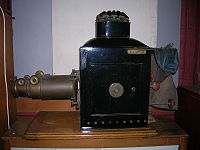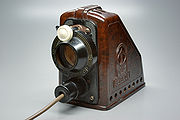
Opaque projector
Encyclopedia

Lens (optics)
A lens is an optical device with perfect or approximate axial symmetry which transmits and refracts light, converging or diverging the beam. A simple lens consists of a single optical element...
is used to focus an image of the material onto a viewing screen. Because they must project the reflected light, opaque projectors require brighter bulbs and larger lenses than overhead projectors. Care must be taken that the materials are not damaged by the heat generated by the light source. Opaque projectors are not as common as the modern "overhead".
Opaque projectors are typically used to project images of book pages, drawings, mineral specimens, leaves, etc. They have been produced and marketed as artists’ enlargement tools to allow images to be transferred to surfaces such as prepared canvas, or for lectures and discourses.

History
The opaque projector is a predecessor to the overhead projectorOverhead projector
An overhead projector is a variant of slide projector that is used to display images to an audience.-Mechanism:An overhead projector typically consists of a large box containing a very bright lamp and a fan to cool it. On top of the box is a large fresnel lens that collimates the light...
. The light source in early opaque projectors was often limelight
Limelight
Limelight is a type of stage lighting once used in theatres and music halls. An intense illumination is created when an oxyhydrogen flame is directed at a cylinder of quicklime , which can be heated to 2572 °C before melting. The light is produced by a combination of incandescence and...
. Incandescent light bulb
Incandescent light bulb
The incandescent light bulb, incandescent lamp or incandescent light globe makes light by heating a metal filament wire to a high temperature until it glows. The hot filament is protected from air by a glass bulb that is filled with inert gas or evacuated. In a halogen lamp, a chemical process...
s and halogen lamp
Halogen lamp
A halogen lamp, also known as a tungsten halogen lamp, is an incandescent lamp with a tungsten filament contained within an inert gas and a small amount of a halogen such as iodine or bromine. The chemical halogen cycle redeposits evaporated tungsten back on to the filament, extending the life of...
s are most commonly used today.
In the early and middle parts of the 20th century, low-cost opaque projectors were produced and marketed as toys for children.
In educational settings, the specific role of the opaque projector has been superseded by the document camera
Document camera
Document cameras, also known as image presenters, visual presenters, digital visualizers, digital overheads, and docucams, are real-time image capture devices for displaying an object to a large audience...
, a lighted table with a fixed video camera
Video camera
A video camera is a camera used for electronic motion picture acquisition, initially developed by the television industry but now common in other applications as well. The earliest video cameras were those of John Logie Baird, based on the electromechanical Nipkow disk and used by the BBC in...
above it. The image from the camera is displayed using a separate projector. The document camera is also called a desktop presenter unit or opaque projector.
Types
At the beginning of the 20th century, projection was split into two classes: " If the light traverses the object, the projection is said to be diascopic, if by reflected light, episcopic.".Two main classes of opaque projectors thus existed:
- the episcope, which solely projected images of opaque objects
- the epidiascope, which was capable of projecting images of both opaque and transparent images
External links
- Episcopes and epidiascopes, photographs of a collection.
- Historic Ross Epidiascope
- A Description of the Braun Paxiscope unit

